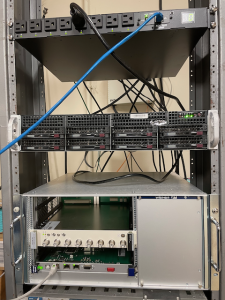General Information
Collection of specs for LV/HV PSU and associated infrastructure
B84 EPP Lab Setup
The B84 EPP lab DAQ readout and PSU communications are supported by the rack at the 'ATLAS corner', network switch and lab supplied on the test bench. The nerve system for this infrastructure is the 1 GE ATLAS ITK network centered on a pair of linked network switches that offers copper ethernet sockets for DAQ readout components, scopes and crate hubs. A long fiber link also connects this network with the ATLAS rack in the B84 lower floor server room which hosts the RDDEV111 Linux server and ATLAS ATCA shelves. EPP lab also has a WiFi router connected to the ATLAS ITK network to allow half of the B84 ATLAS corridor offices closer to the EPP lab to reach this network by WiFi. Key equipment that require remote power controls can take regular 110V A/C power from ports served by the TripLite PDU in the rack.
EPP lab ATLAS rack Top: TripLite PDU unit for remote power control Middle: FELIX-712 Bottom: MPodC crate containing the ISEG HV module |
|---|
The RDDEV111 server is the central hub that resides on both the SLAC public network and ATLAS ITK internal network, where various test DAQ and monitoring applications can be launched from. It also hosts disk space for test software and firmware and code build. Test data are also expected to be hosted here. Access to RDDEV111 can be via ssh from any node on the SLAC public network with your regular UNIX login for approved ATLAS users. Please send access requests to Matthias Wittgen. RDDEV111 also hosts a name server so that you don't have to remember the IP address of you favorite DAQ/monitoring equipment on the ATLAS ITk network but refer to them by node name, once logged on to RDDEV111. Your can also check the physical IP address an alias command for any name in case you need it (detailed instructions to come).
X Display/Terminal with fastx3
Many DAQ and monitoring applications may need to run from RDDEV111 to open X windows for display. The X windows that are directed to your remote laptop/PC using regular X utilities (such XQuartz on MAC) are typically rather sluggish in performance due the the heavy network traffic generated by the X protocol. An alternative X display utility fastx3 within your remote laptop browser can be a more performant option. You can connect to the SLAC fastx3 server at: https://fastx3.slac.stanford.edu:3300/welcome to add ("+") e.g. a Terminal session, from which you can ssh to rddev111 and run an application from the terminal which will also throw X displays within that browser session window.
